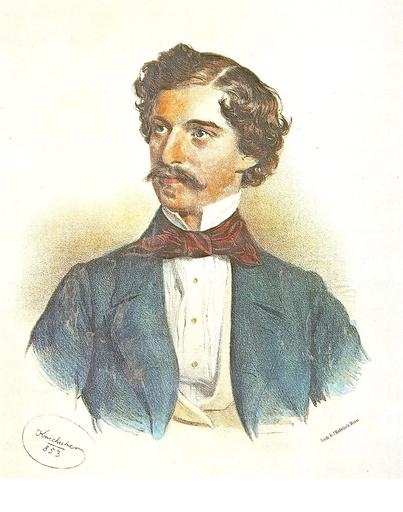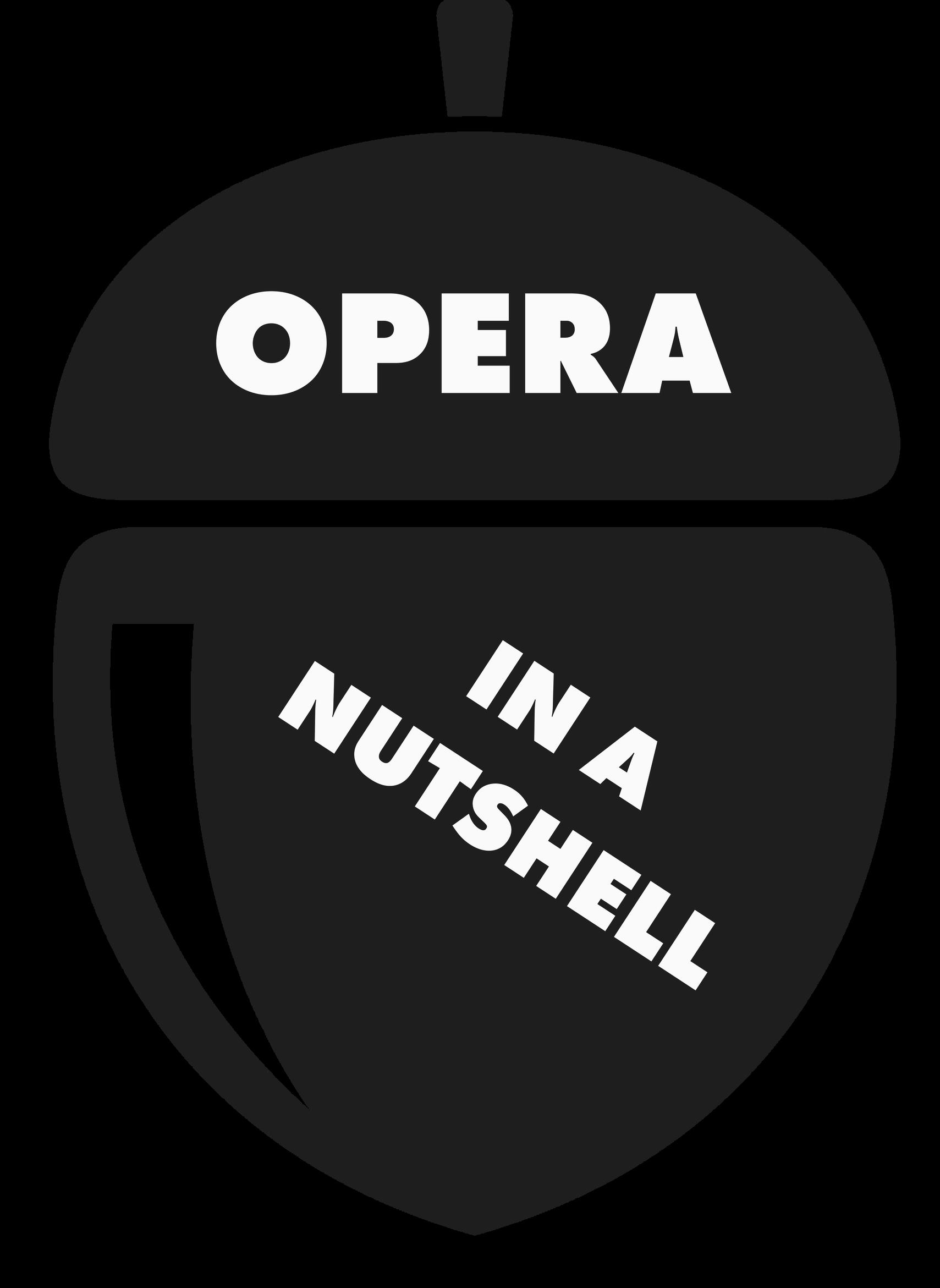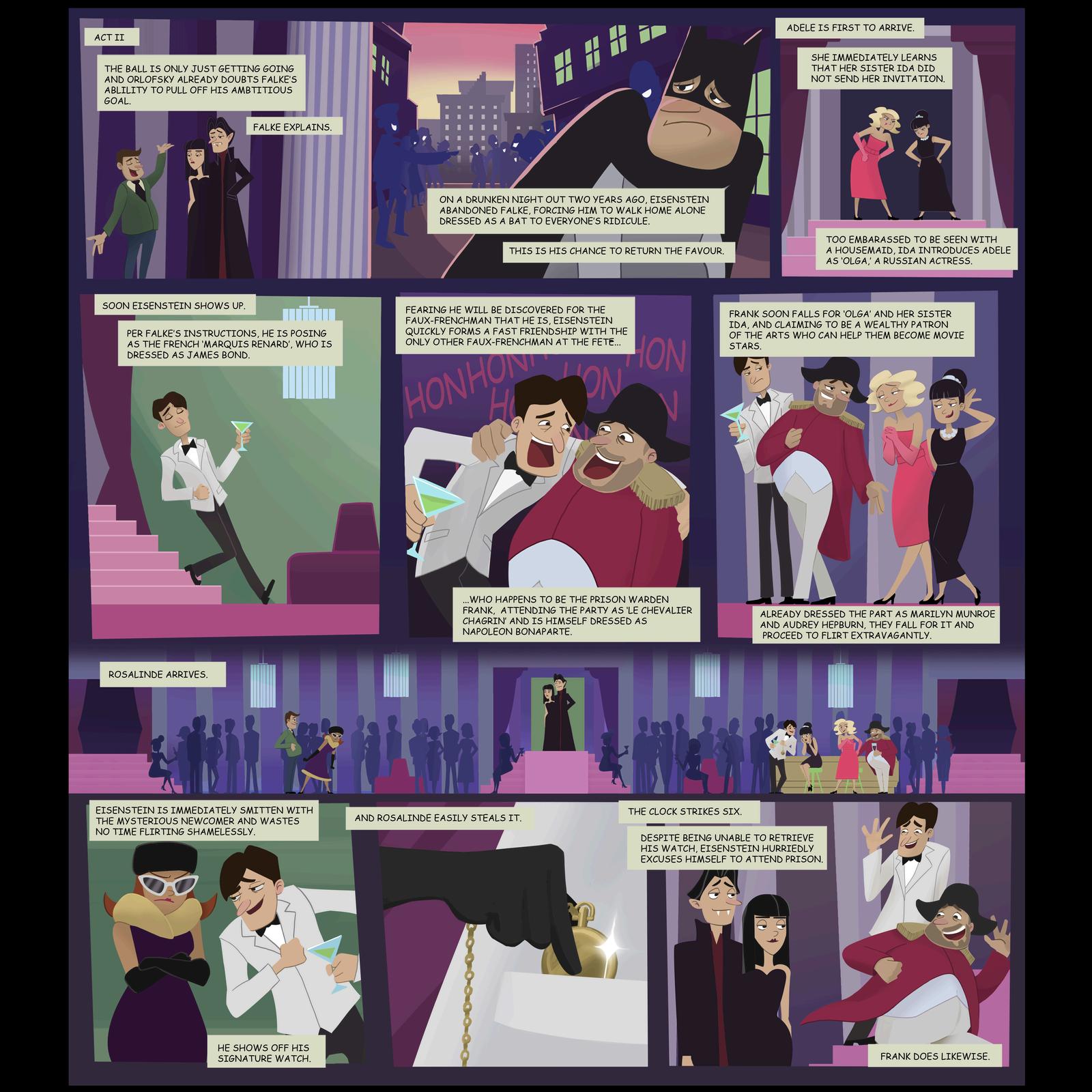2024 Study Guide


October 26-November 3, 2024
Dear Friends,
Opera is an incredible unification of all the artistic disciplines and we hope that you have a wonderful time at our production of Strauss’s Die Fledermaus. E D U C A T I O N A T V A N C O U V E R O P E R A
Producing opera is no easy task,
and what you will see on the stage is the months of hard work from directors, con designers, technicians, musicians, marketing staff, and of course, SINGERS.

We hope you will share the details of this exciting experience with your friends and family, and share the passion for this incredible art form with them!
See you at the opera,
Ashley Daniel Foot Ashley D Foot
Director of Engagement and Civic Practice

STUDY GUIDE TEAM
DIRECTOR OF ENGAGEMENT, CIVIC PRACTICE | ASHLEY DANIEL FOOT EDITOR | JANE POTTER ILLUSTRATIONS | AMY FIELDER
Die Fledermaus ABOUT
Join the party: Strauss’ most-beloved operetta kicks off a celebratory 65th anniversary with laughter and mischief. With a title that translates to “The Bat” (sometimes even presented as “The Revenge of the Bat”), you’d be forgiven for expecting some ominous dark fluttering while gravel-strafed voices say intense things indecipherably. But with its huge chorus, boisterous party scene, and rousing songs like “King Champagne”, Strauss’ beloved operetta absolutely radiates charm, wit, and good-natured mischief! An audience favourite since its 1874 premiere, Die Fledermaus remains the mostperformed operetta in the world for good reason. This vaudeville and farce-inspired comedy masterwork revels in effervescent odes to drinking, dancing, dining, laughing, and, well, more drinking, while a madcap plot pinballs through masquerade and mistaken identities, romantic dalliances, pranks and payback. Ashlie Corcoran returns to direct her second Vancouver Opera season opener in a row, having helmed the fantastical Magic Flute in 2023, while the high-spirited score is conducted by Vancouver Opera Music Director Jacques Lacombe.

The Inside Vancouver Opera Podcast is a unique backstage glimpse into the world of Vancouver Opera.
Join us as we chat with opera experts, artists, Vancouver Opera staff and others to explore the world of opera on and off the stage.
This podcast offers an insider’s glimpse into the artistry, experiences, and perspectives of the talent involved in taking breathtaking opera productions from the page to the stage.

vancouveropera.ca/ podcast/
WHAT IS
Operetta?
How is operetta different from traditional opera?
Operetta differs from traditional opera in several ways: tone, style, music, and length.

Where traditional opera deals with serious topics, operettas are typically much lighter in tone, often incorporating lighthearted themes around deception, trickery, mistaken identities, love, and friendship. The music in an operetta also follows the lighthearted nature of the themes in its bright and catchy nature, with a mix of spoken word and sung dialogue similar to that of a musical.
Another difference between operetta and opera is in length. Where traditional opera can sometimes last four hours, or multiple acts that take days to perform such as Wagner’s Ring Cycle, operettas usually last three hours at the most with a much lighter feel.
In keeping with the overall lighter tone and feel of an operetta, costumes and set design take on a theatrical feel, often using bright colours and playful props in keeping with the often humourous plot lines.
And while operettas often feature less formal musical arrangements and vocals, the singers and performers require the same exacting training and skills as those performing in traditional operas such as the ability to project, and precise vocal control.
Johann Strauss II FASCINATING FACTS
On October 25, 1825, Johann Baptist Strauss II was born in Vienna, the oldest son of Johann Strauss I and Maria Anna Streim.
Knowing how tough it was to succeed, Johann Strauss II’s father did not encourage the younger Strauss to follow a career in music. So when Strauss Jr. secretly learned to play the violin, his father was very angry. He would have preferred if his son were a banker
Following the death of his father in 1849, Strauss took over the very popular Strauss Orchestra, quickly becoming known as The Waltz King.
Among his best known compositions are the instantly recognizable and inspired melodies of the Blue Danube Waltz, the lively Pizzicato Polka, and the rousing Radetsky March.

The initial performance of the Blue Danube was a failure: the audience hated the lyrics. Strauss tried again later that year in Paris, this time performing the piece as an instrumental.
Strauss’s grandfather was a Hungarian Jew. In Germany in the 1930s and 40s the Nazi party praised Strauss’ music as ‘ so German’ but downplayed his Jewish ancestry.
Strauss was a prolific composer, penning nearly 600 compositions during his lifetime.
Strauss died in 1899 in Vienna, after suffering from pneumonia, at the age of 73.

WHO’S WHO Die Fledermaus









SYNOPSIS
ACT I
1967, Summertime
Outside the Eisensteins’ apartment, the tenor Alfred serenades his old flame Rosalinde, who is now married to Gabriel von Eisenstein. Adele, Rosalinde’s chambermaid, tries to get the night off to attend a glamorous New Year’s Eve ball to which her sister has invited her. She tells her mistress she must visit her sick mother, and Rosalinde relutantly agrees. Alfred appears and begins to sing to Rosalinde Hearing someone coming, she sends Alfred away just as Eisenstein and his lawyer, Blind, arrive from a session in court: Eisenstein has been sentenced to eight days in jail for assaulting a police officer and must begin his term that very night. He angrily dismisses Blind. His friend Falke urges Eisenstein to delay going to jail until morning and instead join him at a Hollywood-themed party being held at the private cinema of the wealthy Prince Orlofsky. Falke tells Eisenstein to bring along his infamous pocket watch to charm the ladies. While Eisenstein changes, Falke invites Rosalinde to the party as well, telling her that if she comes in disguise, she’ll be able to observe her husband flirting with other women. Reluctant at first, Rosalinde changes her mind at the chance to catch her husband flirting with other women. Eisenstein leaves for ‘jail’ in evening dress as Alfred arrives to have dinner with Rosalinde. Their rendezvous is interrupted by the prison warden Frank, who has come to arrest Eisenstein, but carts Alfred off to jail instead.

Opera plots explained in an instant.
Watch a Opera in a Nutshell explain Die Fledermaus here:

ACT II
At the party, Prince Orlofsky doubts that Falke’s promised evening of entertainment will brighten his spirits. Adele arrives dressed as Marilyn Monroe to the surprise of her sister Ida, a dancer in the ballet Swan Lake, but dressed tonight as Audrey Hepburn, who claims she never invited her. Ida and Adele decide to present her as a Russian actress named Olga. Eisenstein enters, posing as the Frenchman Le Renard, also disguised as James Bond, per Falke’s instructions. He immediately recognizes Adele as his wife’s maid, but she laughs him off Frank is also posing as a rich Frenchman, Le Chevalier, and he and Eisenstein become fast friends. Frank is so taken with Ida and “Olga” that he pretends to be a patron of the arts to impress them. Finally, Rosalinde arrives, disguised as a Hungarian countess. When a smitten Eisenstein starts flirting with her, she manages to steal his pocket watch. Midnight is approaching, and Falke entertains the guests with the story of how he earned the nickname of Dr. Fledermaus: one drunken evening, when he was dressed as a bat for a costume ball, his best friend Eisenstein played a practical joke on him that made him the laughingstock of Vienna The crowd toasts drink, love, and friendship until midnight The guests party through the night. As the clock strikes six, Eisenstein, whose attempts to retrieve his watch from Rosalinde have failed, rushes off to jail.
ACT III
Frosch the jailer, eating donuts and drinking coffee, is vexed by the late arrival of her boss, Frank, and by the nonstop singing of Alfred in cell number 12. A drunken Frank finally appears. Ida and Adele arrive, per Falke’s instructions still hoping Frank might further their stage aspirations Frank reveals that he is not a rich Frenchman, just as Eisenstein arrives He is surprised to learn his cell is already occupied by a man who claims to be him and who was found in his apartment with Rosalinde. Blind arrives, claiming he was summoned by the man in cell 12 to oversee Alfred’s release. Determined to get to the bottom of the matter, Eisenstein disguises himself as the lawyer in order to confront Alfred At that moment, Rosalinde rushes in. She tries to secure Alfred’s release and asks “Blind” to press divorce charges against her errant husband, but is offended when the “lawyer” seems to take Eisenstein’s side. Dropping his disguise, Eisenstein accuses his wife of promiscuity, at which point Rosalinde produces his watch. Both lament the impasse at which they’ve arrived, admitting that divorce would be a shame, since they really do love each other. Falke arrives to gloat over the success of his plan only to find the couple falling into each other’s arms and to discover Adele, Frank, and Frosch happily embarking on new careers Orlofsky arrives just in time to hear the story—and breaks into hysterical laughter. All sing a final paean to the joys of champagne.
Die Fledermaus
COSTUMES
All the costumes you see on stage in Die Fledermaus were custom made for the original Opera de Québec production, and are on loan to Vancouver Opera. Because performers and singers are all different shapes and sizes, many alterations and adjustments need to be made, all of which are done in-house at Vancouver Opera in the extensive Costuming department.



Die Fledermaus
COMIC STRIP
illustrated by Amy Fielder







WHAT IS OPERA?
WHERE DID OPERA COME FROM?
Opera came from Italy, just like gelato! The word opera means ‘work’ in Italian, as in work of art, not homework.
WHO MAKES OPERA HAPPEN?
Opera is a group effort by conductors, musicians, singers, dancers, set designers, costume creators, lighting experts, directors, theatre staff, make-up artists, wig makers, carpenters, prop designers, and more, to tell a story, sing, dance, and entertain the audience all the same time.
NO MICROPHONES?
Unlike Drake or Taylor Swift, opera singers don’t use microphones. Instead, they learn to project their voices. They may go from projecting over the sound of the live orchestra in one moment, to dropping to a near whisper in the next moment (just like your school principal during assemblies).
To protect each other’s hearing, opera singers cannot face directly towards each other while singing. Ear plugs are not allowed.
HOW LONG DO YOU HAVE TO TRAIN?
Opera singers often have as many years of education as physicians, and must continue training throughout their career.
HOW LONG ARE OPERAS?
Operas can be up to four hours long, which may be how long French class feels, but at least you don’t have to wear a costume, make-up, possibly a wig, sing and dance under hot lights, and memorize an entire opera, like the performers do.
NO SKIPPING FRENCH CLASS!
Composers write in their language, and sometimes in second or third languages too, so opera singers must often learn English, French, German, Italian, and even Russian and Czech if they want to perform worldwide. And in case you ’ re wondering, ‘ice cream ’ in Czech is ‘zmizlina’.
DOES IT PAY THE BILLS?
If you were a top opera singer, you could make as much as $20,000 per performance.
WHAT OTHER SKILLS DO OPERA SINGERS NEED?
Singers must learn to brush off negative reviews in time to perform the same show the following night.
FUN FACT
Opera has been around for as long as gelato, which is just over four hundred years.
GLOSSARY
OPERA TERMS
ACTS / SCENE
Acts and scenes are ways of categorizing sections of operas An act is a large-scale division of an opera, and each opera will typically include from two to five acts Acts can be subdivided into scenes, which are often differentiated by a change in setting or characters
ADAGIO
Literally “at ease, ” adagio is a tempo marking that indicates a slow speed. An adagio tempo marking indicates that the performer should play in a slow and leisurely style
Italian for “cheerful” or “joyful,” Allegro is the most common tempo marking in Western music, indicating a moderately fast to quick speed. ALLEGRO
ARIA
A song for solo voice accompanied by orchestra.
BRAVO / BRAVA / BRAVI
Italian for “nicely done”; shouted by audience members after a performance. “Bravo” for men, “Brava” for women, and “Bravi” for all.
CHORUS
A section of an opera in which a large group of singers performs together, typically with orchestral accompaniment.
CRESCENDO
A gradual raising of volume in music achieved by increasing the dynamic level. When music crescendos, the performers begin at a softer dynamic level and become incrementally louder.
ENSEMBLE
A musical piece for two or more soloists, accompanied by orchestra. Types of ensembles include duets (for two soloists), trios (for three soloists), and quartets (for four soloists).
FORTE
Meaning “loud” or “strong” in Italian, forte is a dynamic level in music that indicates a loud volume. Adding the suffix “-issimo” to a word serves as an intensifier since forte means “loud,” fortissimo means “ very loud.”
LIBRETTO
The text of an opera, including all the words that are said or sung by performers.
OVERTURE
An instrumental piece that occurs before the first act as an introduction to an opera.
RECITATIVE
Speech-like singing in-between musical numbers that advances the plot.
SCORE
The complete musical notation for a piece, the score includes notated lines for all of the different instrumental and vocal parts that unite to constitute a musical composition
TEMPO
Literally “time” in Italian, tempo refers to the speed of a piece of music

MATCH THE OPERA TERMS
DM A CHARACTER
For example, you may wonder:
Hey, Eisenstein, what did you do to go to jail?
While Die Fledermaus was composed and the libretto written in 1874, and this adaptation sets the operetta in a more modern 1967, life was still different then, than it is now. How, if at all, do these differences affect our appreciation and understanding of the operetta?
For example, how might the plot unfold differently if the characters had cell phones? Would Eisenstein still have a pocket watch?
Despite these differences many of the themes around human emotions, behaviours, and motivations are as relevant today as they were then, and so are your questions about the characters and their decisions:
Why did Falke blame Eisenstein for his humiliating experience drunk, and dressed as a bat? Is Rosalinde’s life fulfilling? How does she spend her time?
Resources: Generate a chat transcript
After you have watched the performance, work in pairs and choose a character whose decisions or behaviours intrigued you, and engage them in a discussion. Ask them questions about their choices, and then respond on their behalf
YOU COULD ACTIVITY
Use a DM or texting generator. Compose a series of emails. Go Old School and write a letter.


